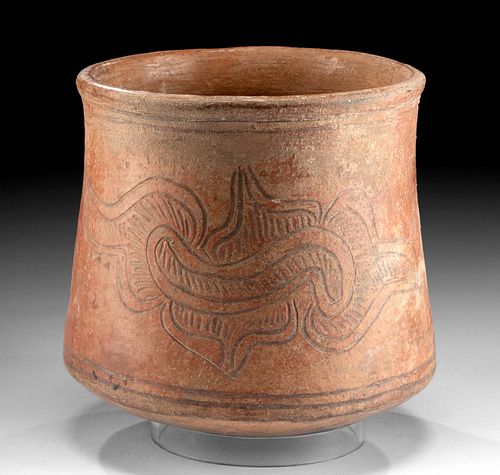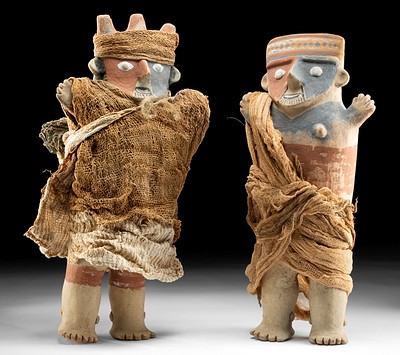Olmec Pottery Jar w/ Incised Glyph, ex Komor
Lot 93c
About Seller
Artemis Fine Arts
686 S Taylor Ave, Ste 106
Louisville, CO 80027
United States
Selling antiquities, ancient and ethnographic art online since 1993, Artemis Gallery specializes in Classical Antiquities (Egyptian, Greek, Roman, Near Eastern), Asian, Pre-Columbian, African / Tribal / Oceanographic art. Our extensive inventory includes pottery, stone, metal, wood, glass and textil...Read more
Categories
Estimate:
$5,000 - $7,500
Absentee vs Live bid
Two ways to bid:
- Leave a max absentee bid and the platform will bid on your behalf up to your maximum bid during the live auction.
- Bid live during the auction and your bids will be submitted real-time to the auctioneer.
Bid Increments
| Price | Bid Increment |
|---|---|
| $0 | $25 |
| $300 | $50 |
| $1,000 | $100 |
| $2,000 | $250 |
| $5,000 | $500 |
| $10,000 | $1,000 |
| $20,000 | $2,500 |
| $50,000 | $5,000 |
| $100,000 | $10,000 |
| $200,000 | $20,000 |
About Auction
By Artemis Fine Arts
May 19, 2022
Set Reminder
2022-05-19 10:00:00
2022-05-19 10:00:00
America/New_York
Bidsquare
Bidsquare : Fine Antiquities | Ethnographica | Fine Art
https://www.bidsquare.com/auctions/artemis-gallery/fine-antiquities-ethnographica-fine-art-9350
Featuring a very special collection of Fine Art from the Hollywood Hills, including Picasso & Rookwood ceramics! Also included are many fine examples of classical antiquities, ancient, and ethnographic art from cultures encompassing the globe. Artemis Fine Arts info@artemisfinearts.com
Featuring a very special collection of Fine Art from the Hollywood Hills, including Picasso & Rookwood ceramics! Also included are many fine examples of classical antiquities, ancient, and ethnographic art from cultures encompassing the globe. Artemis Fine Arts info@artemisfinearts.com
- Lot Description
Pre-Columbian, Mexico, Veracruz region, Olmec culture, ca. 1000 to 800 BCE. An exemplary pottery jar presenting a round yet stable base and thick walls that gently slant inward as they rise to a flared, annular rim. Enveloped in pale orange slip, the fascinating vessel has been adorned with incised decoration of 2 glyphs, each displaying a swirling, abstract form of a central serpentine shape surrounded by 4 petaloid motifs, all embellished by repeated, linear striations. A pair of horizontal lines encompass the rim and base, forming a lovely border for the central glyph design. Olmec vessels like this were portable objects that traveled around their area of influence to places like Tlatilco, Tlapacoya, Las Bocas, and San Jose Mogote. These jars were made throughout the wide area of interconnected chiefdoms that we consider the Olmec, and were often used to hold honey, cocoa, and other food. A stunning and rare example! Size: 6.6" Diameter x 7" H (16.8 cm x 17.8 cm)
The glyphs on this carving are probably epi-Olmec or proto-Mayan. Epi-Olmec, like Mayan, consists of glyphs, often written in lines or columns. Although not all of it has been deciphered, what we know of this language is that it describes religious notions and, to a lesser extent, socio-political matters. It is not clear if glyphs are both pictographic and ideographic, or what role phonograms might have played, and this remains a hotly studied component of Mesoamerican archaeology. With all these questions, can we say anything about this vessel? Barring some exceptional circumstances, it was owned by a wealthy person, and buried with them; its glyphs probably speak to the status of the individual or offer a prayer.
Provenance: private Hidden Valley Lake, California, USA collection; ex-Mr. and Mrs. Mayer collection, New York City, New York, USA, acquired March 28th, 1970; ex-Komor Gallery, New York, New York, USA
All items legal to buy/sell under U.S. Statute covering cultural patrimony Code 2600, CHAPTER 14, and are guaranteed to be as described or your money back.
A Certificate of Authenticity will accompany all winning bids.
PLEASE NOTE: Due to recent increases of shipments being seized by Australian & German customs (even for items with pre-UNESCO provenance), we will no longer ship most antiquities and ancient Chinese art to Australia & Germany. For categories of items that are acceptable to ship to Australia or Germany, please contact us directly or work with your local customs brokerage firm.
Display stands not described as included/custom in the item description are for photography purposes only and will not be included with the item upon shipping.
#170500Some stable surface fissures throughout. Expected nicks, abrasions, and a few minor chips. Some flaking to surface and areas of fire darkening. Otherwise, intact and excellent with nice remaining slip and impressively preserved incised detail. Matthias Komor collection label on base.Condition
- Shipping Info
-
All shipping is handled in-house for your convenience. Your invoice from Artemis Gallery will include shipping calculation instructions. If in doubt, please inquire BEFORE bidding for estimated shipping costs for individual items.
-
- Buyer's Premium



 EUR
EUR CAD
CAD AUD
AUD GBP
GBP MXN
MXN HKD
HKD CNY
CNY MYR
MYR SEK
SEK SGD
SGD CHF
CHF THB
THB















